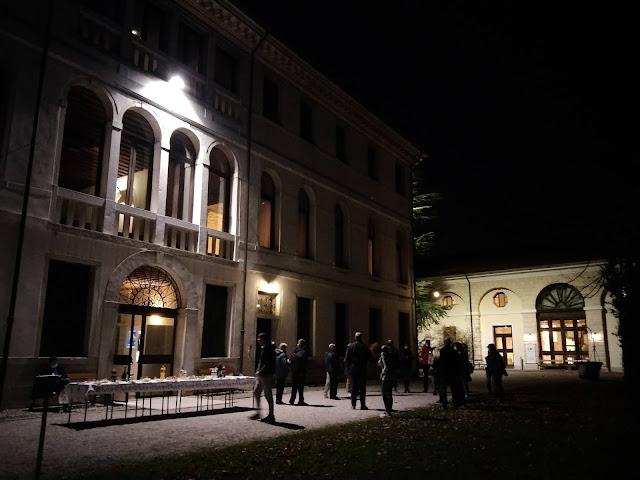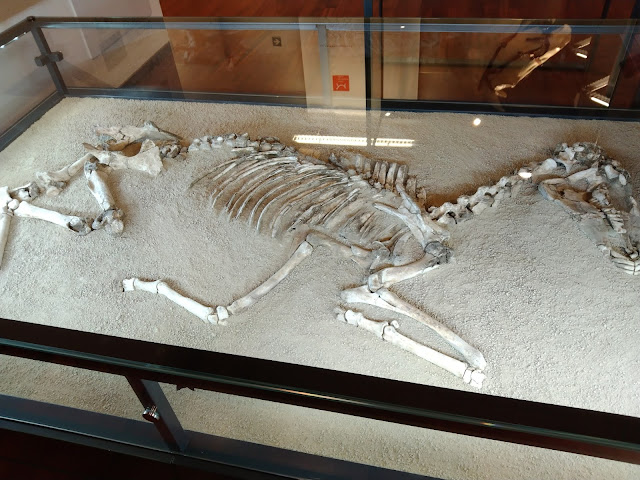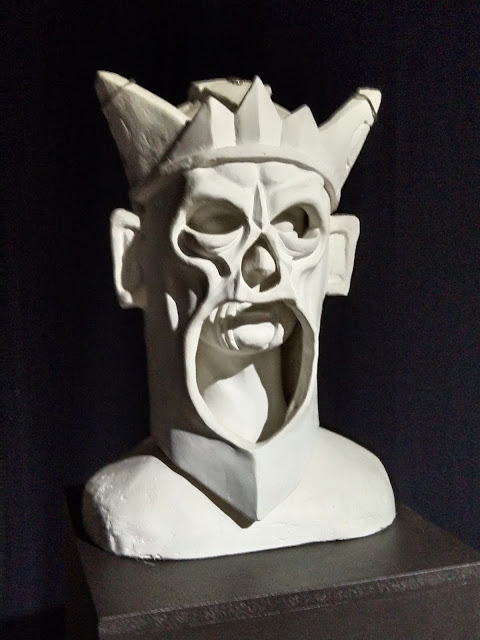Oderzo (Veneto, Italy): Palazzo Foscolo and its archeo and art museums though its artists
During the Italian National Day of Urban Walking in Italy which promoted slow tourism, we visited Oderzo, a lovely town of 21.000 inhabitants, located about 50 km north of Venice.
Oderzo is a unique place for its long history starting from the ancient Romans and its Roman archaeological beauties are open to all visitors. However, Oderzo has much more to tell because it is people who make places and therefore we discovered local artists and art works hosted in Palazzo Foscolo, artists who made Oderzo great.
 |
| The night view of Palazzo Foscolo and the barchessa hosting the Archeo Museum |
WHERE IS ODERZO AND HOW DO I GET TO ODERZO?
In the fertile Venetian plain of Italy, north east of Italy. Oderzo is 29 km from Treviso, and about 57 km north of Venice. Reaching Oderzo is not difficult: by car it takes about an hour (57 km), by train it takes about two hours from Venice: take the train to Treviso and change for Oderzo.
PALAZZO FOSCOLO: VISITING THE ARCHEOLOGICAL AND ART GALLERIES
Oderzo is famous for its history at the heart of the dominion of the ancient Romans, for its monumental and noble painted palaces and for the Monticano river which offers wonderful views, but getting lost and wandering through its streets and squares is the solution to experience the spirit of Venetian city and discover its most authentic face.
PALAZZO FOSCOLO: SOME INFORMATION
In fact, the most prestigious buildings appear in every corner of the town streets. Our itinerary starts from Palazzo Foscolo, built in one thousand five hundred and eighty-two by the Venetian Contarini family, and is one of the treasures of Oderzo.
The Contarini family called famous artists to decorate the palace but it is not known who was the architect. It is known that who decorated the interior stuccos was the great master Alessandro Vittoria, buried in the Church of San Zaccaria in Venice.
 |
| The amazing stuccos inside Palazzo Foscari |
 |
| Stuccos in Palazzo Foscari |
Palazzo Foscolo was founded as a noble palace flanked by two side barchesse of which only one survives today and houses the Archaeological Museum, while inside the villa there is the Modern Art Gallery Alberto Martini.
Originally inside the perimeter of the building there was a wonderful huge fish pond in an Italian garden decorated with statues, very similar to the garden of Villa Pisani in Strà in the province of Venice. Today all of the garden and fish pond in Palazzo Foscolo have disappeared.
The Palace passed to the Foscolo family after several changs of ownership, but with the First World War it became the Austro-Hungarian command and the Countess Anna Foscolo, the last remaining member of the family, had to leave.
Subsequently fires destroyed a part of the villa, but in 1975 the Municipality of Oderzo bought and restored it, trying to partially recover its ancient splendor and hosting the two museums, the Eno Bellis archeological museum, and the Alberto Martini Art Gallery.
THE TWO MUSEUMS OF PALAZZO FOSCOLO
THE ARCHEOLOGICAL MUSEUM "ENO BELLIS"
In the early nineties the Archaeological Museum Eno Bellis was set up in the barchessa with the archaeological heritage and findings from the excavations of ancient Opitergum, for example you can see many amphorae, beautiful mosaics and archaeological finds that cover centuries of Oderzo history, even if the evidence dates back mainly to the Roman and pre-Roman period.
 |
| The display on the ground floor of the archeo museum Eno Bellis |
Among the most interesting finds relating to the necropolis found in Oderzo there is a collection of bronze statues including warriors. The museum also has a tomb of an Iron Age horse from a necropolis ...and even its his harness!
 |
| The horse skeleton displayed in the archeo museum |
On the ground floor of the archeo museum there is the section dedicated to the finds mostly belonging to funerary Roman monuments, coming from Oderzo.
There are pieces telling us about Roman life with the presentation of different types of materials: coins, loom weights, materials relating to burials and a good number of glass balsam bottles or glass cups.
The collection of bronze statuettes is rich, including figurines depicting divinities, decorative elements and personal adornments.
 |
| Roman bronze statuettes |
 |
| Funerary heads in Eno Bellis archeo museum |
 |
| Roman loom weights and an antefix, the covering tiles of a roof |
 |
| More bronze statuettes and a precious blue glass vessel |
 |
| The amazing blue glass vessel |
But the striking part is the exhibition of late antique polychrome mosaics, which include the so-called "hunting", "Romanus" and "cupbearer" mosaics.
 |
| The mosaics in the archeo museum, the cup bearer |
 |
| The hunting scene of the Roman mosaics |
 |
| The amazing Roman mosaics in the archeo museum |
 |
| The museum Roman mosaics |
THE SOUL OF THINGS: A TEMPORARY EXHIBITION ABOUT THE REMAINS OF THE ROMAN NECROPOLIS
By pure chance yesterday was also the last day of the temporary archaeological exhibition, which displayed remains from the necropolis of Oderzo and loaned by other museums, such as the toy horse of a buried child found in a tomb of the late II-III century AD.
 |
| A Roman baby horse toy |
And many other objects such as jewelery, combs, buckles that tell us about life of a society through the centuries; the world of the living that re-emerges from the city of the dead, thanks to the exhibition promoted and organized by Oderzo Cultura.
 |
| An amber necklace |
 |
| A decorated cup |
 |
| A blue glass jug |
 |
| A comb |
 |
| A spindle and lanterns |
After visiting the archeo museum Eno Bellis you can visit the open-air archaeological remains spread around Oderzo: walking through the streets, thanks to the urban renewal works carried out mainly in the 80s by the famous architect Toni Follina, you can admire the Roman villas and forum.
Roman ruins are all scattered around the city and were discovered under the buildings during the excavation to make new foundations.
 |
| The Roman mosaics under a building in Oderzo |
 |
| Mosaics in Oderzo |
 |
| Moro Roman remains in town |
THE ART GALLERY "ALBERTO MARTINI"
In Palazzo Foscolo, there is also the art gallery named after the master and painter / engraver Alberto Martini which houses many works by the artist born in Oderzo in 1876. Alberto Martini's self-portrait stands out as you enter the floor which hosts his ink lithographs and paintings.
 |
| Self portrait of Alberto Martini in his art gallery |
WHO WAS ALBERTO MARTINI
Alberto Martini was born in Oderzo in the second half of the 19th century from a noble mother from the Spineda family and a painter father. Martini is a precursor of the great surrealist painting and is definitely eclectic. He will be successful in Milan and will live in Paris, Vienna, as well as partecipates in many Venice Biennali and will be in contact with the great families of the international jet set.
Looking at his paintings is really scary: he is definitely a surrealist and certainly had a strong taste for the macabre. In his writings he writes that real life is boring and he often takes refuge in dreams because the reality in dreams is more interesting as it is deformed.
The artist would get up to draw at night and lived in a sort of parallel world. He illustrates great novels such as the 19 drawings of the Divine Comedy and illustrations for Edgar Alla Poe. His works are amazing!
“To learn pen drawing, a difficult and sharp instrument like the violin, it is necessary to work day and night for many years”. These are the words of Alberto Martini (1876-1954), and we understand why. Skeletons, monsters, apes, crows and skulls make up Martini's imagination.
The master imagines and draws a crazy project in his lifetime: the Tetiteatro or theater of the sea. Martini sees it in his dreams (or nightmares?) and draws it in more many illustrations: a theater completely immersed in a swimming pool with a part of its raised stage on the mainland emerging from the water.
This theatre of the sea project was never successful, but in the 70s the architecht and designer Aldo Rossi presented something similar at the Venice Biennale called the Theatre of the World. Alberto Martini - after his death in 1954 - was forgotten by critics and only thanks to two masters and artists who worked in Oderzo such as Armando Buso and Bevilacqua Alberto Martini's works were moved and found a place in his hometown, Oderzo.
THE MODERN ART GALLERY
In the museum downstairs you can visit the amazing works of other artists in the modern art gallery: they worked in Oderzo and became important part of the international scene, like the master glass maestro Egidio Costantini or the painter, Armando Buso.
VISITING AND ACCESSING PALAZZO FOSCOLO
Palazzo Foscolo is located just outside the historic center of Oderzo (Treviso). Here. Opening hours and updated costs can be consulted on the website of the Fondazione Cultura di Oderzo. You need the Green Pass for the visit.
 |
| Amphorae in the archeo museum |
 |
| Mosaics in Eno Bellis archeo museum |
EATING IN ODERZO
We have personally tried the following restaurants on different occasions which we found all to be excellent:
Gellius: a Michelin-starred restaurant.
Nyu: a lovely informal bistrot, perfect for aperitifs.
Sosteria: an informal excellent winery serving food with a different twist.
Read more blog posts:













